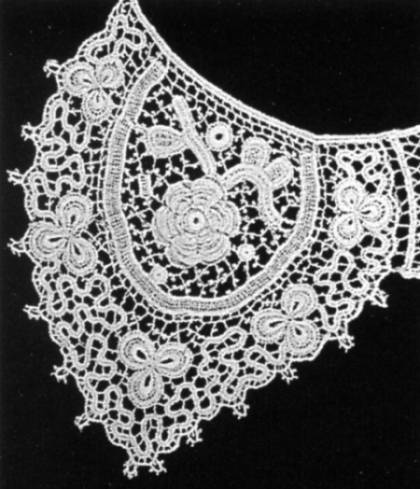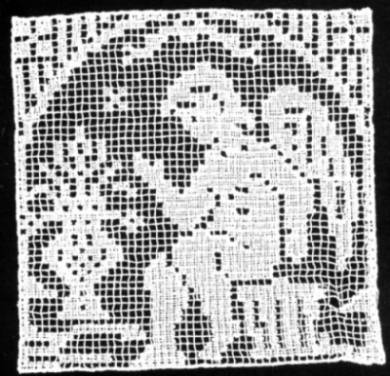
Detail of chemical embroidery,
Imitation of Irish Lace

Chemical embroidery,
Imitation of Filet
| ANNE WANNER'S Textiles in History / publications |
| The Sample Collections of Machine Embroidery
of Eastern Switzerland in the St Gallen Textile Museum in: Textile History, 22 (2), p. 165 - 176, 1992, by Anne Wanner-JeanRichard |
| page 9 of 10 back - next |
| Machine lace: Lace can be produced mechanically by the embroidery machine with specially developed tools for making holes. During the second stage the pattern is embroidered with flat-stitch (Bohrware). Another way is the chemical method, or Aetzstickerei
(see notes 5 and 25). Here the pattern
is first embroidered onto a base fabric which initially
had to consist of an animal fibre such as wool or silk.
The embroidery on it had to be made with a vegetable
fibre, i.e. cotton or linen, and the subsequent chemical
treatment caused the base fabric to disappear entirely
leaving only the solid cotton embroidery. Complicated shapes, like collars, were separated into individual pieces which subsequently were produced in large numbers on the embroidery machines. Later, before they underwent the dissolving process, they were joined together by sewing machine into their final form. The dissolving technique was, moreover, very suited for a persuasive imitation of several kinds of lace, hand-made, with the needle, or even with the bobbin. Otto Alder, for instance, produced a mechanical Venetian lace which he claimed even the expert could not recognise as machine-produced work (25). Also Irish crochet-lace or Sol-lace from Paraguay, could be produced with the chemical method, and especially popular was the mechanical filet lace. |
Finally a very large group
of machine embroideries, namely the coarse
embroidery, must not be forgotten (26).
This meant mostly the production of various types of curtains
on the chain-stitch machine, an
operation which was frequently carried out in neighbouring
Austria (Vorarlberg) for firms in St Gallen. Since
the beginning of the hand embroidery industry, eastern
Switzerland had close connections with Austrian
embroidery. Coarse embroidery was the name for chain-stitch on
cotton muslin and on tulle. The Spachteltechnik
(cutting-out technique) was very successful with
curtain embroidery. Tulle and cotton fabric were put on
top of each other, and both were simultaneously decorated
with chain-stitch. |
|
|
|
|
| In the German area of Saxony (Plauen), too, machine tulle was embroidered. In 1881 the merchant Theodor Bickel, a linguist with great knowledge, attracted attention with it in Paris (29). Plauen's esteem on the international market rose since this new embroidery could be produced with the Schiffli machine. The St Gallen embroidery firm of Reichenbach kept a branch in Plauen for some time. Plauen also maintained a large production industry for coarse embroidery. A large number of pattern sheets from it are kept in the textile library of St Gallen. |
| References: 25 - Alder, Rückschau, p. 55. 26 - Marianne Gächter-Weber, "Vorhangstickerei 1870 bis 1930", in: Stickereizeit (St. Gallen, 1989), p. 69, and Anne Wanner, "Maschinenstickerei", in ibid., p. 80. 27 - Gerhard Wanner, Vorarlbergs Industriegeschichte (Feldkirch 1990), p. 83 |
28 - Jahrbuch des kaufmännischen Directoriums (1888), p. 15 29 - Otto Tröger, "Werde- und Entwicklungsgang der Plauener Industrie" (lecture published in: Neue Vogtländer Zeitung, n.d.). |
| Introduction | Rittmeyer | Grauer | Alder | Ikle | Tschumper | Fraefel | Types | Lace | Reports |
| content | Last revised 25 July, 2004 |